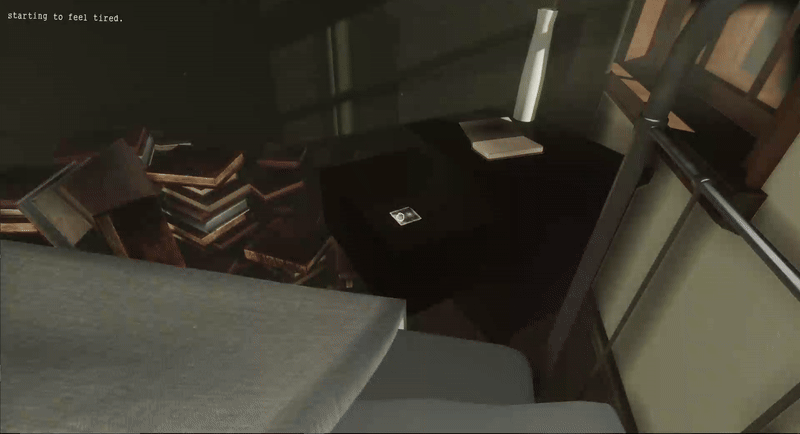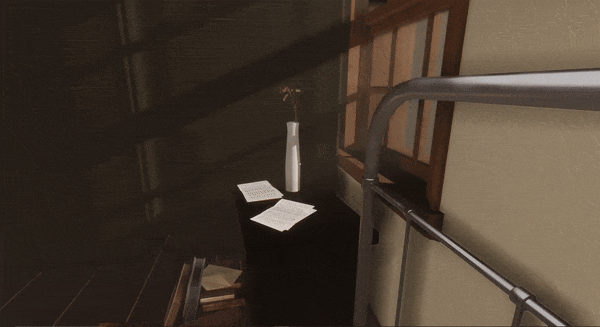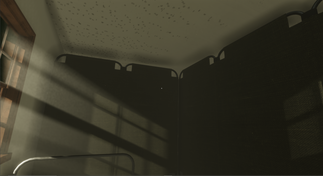hospitalroom
- KB
- Jan 4, 2020
- 4 min read
Updated: Sep 20
Unity | C# | Blender | Modelling | Environment Art
2024
Environment and systems for an atmospheric game set in a mid-1900s hospital with horror elements.
It uses horror conventions to show a character who worsens throughout their hospitalisation - presenting an experience that becomes increasingly tense and surreal over the game's runtime.
hospitalroom is a game about a protagonist confined to a hospital bed and anxiety surrounding long-term hospitalisation - as a project, it was an try at challenging myself to make a game only using a fixed, stationary perspective.
Despite taking place inside a single room, environmental and lighting changes shift the tone from serene to oppressive over the course of the game.
Features:
Atmospheric world and story progression.
Light horror elements - subverting player expectations, building and releasing tension.
Resident Evil 2 (2019)-style item inspection and interaction system.
Use of C# events to structure scenes around a central game manager script.
Design and Development Process
hospitalroom is primarily developed as an environment design project. My overall goals were to spend time away from programming and instead create a project focused on atmosphere and environments.
Environment and Visual Design
The environment I chose to create was a warm, sunlit interior, based on hospital rooms that appear in Wolfenstein: The New Order and Neon Genesis Evangelion.
Based on my own experiences of my family having to regularly go in and out of hospital, I'm left with a strange impression of hospital rooms where I thought they were at once oppressive and tense spaces, but also still and calming. I often left like hospital wards felt frozen in time, and I wanted to see if I could adapt that mixed impression into a game.
The hospital room environment is initially presented as a warm, homely space. The room's colours, and visibly wide space provide a comforting atmosphere. The room makes heavy use of Unity HDRP volumetric lights in an attempt to recreate some of the reference images and add to the atmosphere of a historic hospital ward with some dust particles floating around in the air. Extra dust particle effects were added to further emphasise a relaxing 'dusty room' look.

As the game progresses, Many of the elements of the room shift to feel more cramped and offputting. Curtains are drawn, the room becomes cluttered and the colours shift from orange to a grey-green.

Text Effect


I wanted a diegetic way to present tutorial messages by suggesting the messages were the protagonist’s thoughts / imagination.
I borrowed a 'warping text characters' effect from Killer7 - it made the text appear more surreal, as if it was partly imaginary.

While implementing the effect, there was a bug where the text would appear to wander outside of their lines and jumble up. I liked how it suggested the protagonist's thoughts were becoming confused. I fixed the bug, but deliberately used this ‘jumbled’ effect in the later parts of the game where the protagonist is less lucid.
As the project developed, I started experimenting with building mystery and tension in the scene, using techniques from gothic tropes and horror games.
Narrative, Gothic and Horror Influences
I interested in creating a narrative experience in the game based on long-duration hospitalisation - this was partly influenced by the story of the hospital room from Wolfenstein: The New Order, where the protagonist is hospitalised for years as the world leaves him behind. I thought the setup of long-term hospitalisation left a lot of space for emotional storytelling based on feelings of confinement and hopelessness.

I was inspired by the Presentable Liberty's protagonist who, in a prolonged state of social isolation, becomes emotionally dependant on traces of communication from unseen characters.
In hospitalroom, no other characters are seen. However, letters, visitors' chairs and flowers would suggest the unseen presence of character(s) communicating with the bedridden protagonist.
Over the course of the game, evidence of these visits and attempts to continue communication would start to fade, suggesting that the long hospitalisation was worsening the protagonist’s relationships and forcing them into isolation and anxiety.
I thought it would be fun way to continue this project's focus on environments by having the scene itself express this character's changing emotional state - by having the environment reflecting the character's anxiety.
Though the hospital room is initially peaceful, by the end of the game, the protagonist's environment becomes surreal and oppressive.
To this end, I started developing ideas about using gothic and horror conventions. I specifically liked how how gothic literature often has the protagonist go through a terrifying or unknown 'other' world - the ‘other’ in referring to primary threat or the source of fear, both literal and abstract, that the protagonist must face.
The Silent Hill games are especially famous for their use of this trope. Out of them, Silent Hill 4: The Room has a twist where the unknown 'other' invades the player's safe space, creating horror by leaving the player with nowhere to hide.
Influenced by this technique, I wanted the 'other' world to begin invading the protagonist's regular environment, creating the feeling that the protagonist's safe and familiar space is being encroached on by some unknown threat.
Tension-building and Structure

Early on in development, the game was split up into multiple scenes or 'days', each serving a narrative or pacing purpose. The overall structure of the days were designed to create a natural hero's journey-esque rise and fall of tension.
The game starts with an abrupt, mysterious scene to engage the player and set an ominous first impression. Earlier days are largely setting the scene, setting up imagery and creating a slow buildup of tension.
The middle scenes are meant to rattle the player by removing player agency and disturbing the rhythm of the game loop.
The player has grown used to the game loop and scene transitions from the previous days, however, the third and fourth days force the player out of the control seat by breaking the game loop, forcing scene transitions and introducing unfamiliar imagery.
By the time of the final scenes, tension within the player has been built up from the increasingly oppressive atmosphere of the environment - leading to a final, seemingly apocalyptic scene and hard cut - releasing tension.














